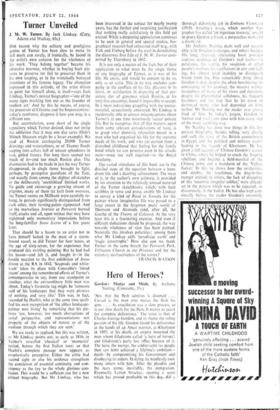Turner Unveiled
ONE reason why the solitary and prodigious genius of Turner has been slow to make its full mark can surely, if ironically, be found in the artist's own concern for the wholeness of his work. 'They belong together' became his obsessive murmur, whether in buying back pic- tures to preserve (or fail to preserve) them in his own keeping, or in the wretchedly betrayed intentions of his famous legacy. The alienation expressed in this attitude, of the artist driven to paint for himself alone, is itself—says Jack Lindsay, Turner's newest biographer—'one of the many signs marking him out as the founder of modern art.' And by this he means, of course, the precursor of Cezanne and the Impressionists: today's syndrome, diagnose it how you may, is a different one.
But accumulation, even short of the single repository which Turner desired, does not invite the addiction that it may one day serve (Oslo's Winch Museum might be a lesser example). We read of Ruskin cataloguing 20,000 Turner drawings and watercolours, or of Thames floods seeping into cellars full of unseen splendours in vast, gilded frames. For long there seemed too much of it—and too much Ruskin also. The discoveries had to be made in just the way Turner disapproved, in single items brought to light, perhaps, by perceptive guardians of the Tate, and usually from among the slighter oil-sketches or the deliberately `unexhibited' finished works. To guide and encourage a growing stream of pilgrims, many of them (at last) from overseas, the Turner rooms on Millbank were carefully re- hung, in periods significantly distinguished from each other, their turning-points signposted. And so the marvellous Interior at Petworth burned itself, cracks and all, upon retinae that may have registered only momentary impressions before the long-familiar Snow Storm of a few years later.
That should be a lesson to an artist not to have himself lashed to the mast of a storm- bound vessel, as did Turner for four hours, at the age of sixty-seven, for the experience that produced this swirling painting. But he had had .his lesson—and felt it, and fought it—in the -hostile reaction to the first exhibition of Snow Storm at the RA in 1842. 'Soapsuds and white- wash' takes its place with Constable's `tinted steam' among the remembered efforts of Turner's contemporaries to say, from one standpoint or another, what the extraordinary little man was about. Today's favourite tag might be 'someone said of his landscapes that they were pictures of nothing, and very like.' This was, in fact, recorded by Hazlitt, who at the same time quali- fied his own recognition of `the ablest landscape- painter now living' by remarking that his pic- tures 'are, however, too much abstractions of aerial perspective, and representations not properly of the objects of nature as of the medium through which they are seen.'
We are ready to applaud, but this was written, as Mr Lindsay points out, as early as 1816, in Turner's so-called `classical' or 'mannerist' period, before the first Italian tour; so that
Hazlitt's complete passage now appears as prophetically perceptive. Either the critic had
second sight or else his evidence strengthens the conviction of essential continuity and con- sistency as the key to the whole glorious con- fusion. This would be a sufficient cue for a new critical biography. But Mr Lindsay, who has
been interested in the subject for nearly twenty years, has the further and surprising justification that nothing really satisfactory in this field yet existed. While a deepening appreciation continues to be seen in general and special studies, bio- graphical research had exhausted itself (e.g., with Falk and Finberg before the war) in demolishing the disastrous first Life of J. M. W. Turner com- mitted by Thornbury in 1862.
It is not only a matter of the facts but of their application to what must be the single theme of any biography of Turner, as it was of his life. He exists, and would be content to do so, only as an artist. This in no way excludes sym- pathy in the conflicts of his life, pleasure in its trivia, or satisfaction in disposing of that per- sistent slur of grossness which Ruskin, at his very first encounter, found it impossible to accept. In a most industrious grappling with the source- material, scrupulously annotated, Mr Lindsay is incidentally able to correct misconceptions about Turner's at one time notoriously `secret' private life. But he recognises that all that matters, apart from some relevant considerations of taste, is to grasp what domestic relaxation meant to a man who had organised his life for the supreme needs of his work, and who yet carried from a disturbed childhood that feeling for the family bond which we can perceive even in his attach- ment—none too well requited—to the Royal Academy.
The varied stimulants of this book are in the detailed steps of the equation between a hum- drum life and a dazzling achievement. The meat of it, in the author's own estimate, is provided by his attention to the relatively unused material of the Turner sketchbooks, which, with their scribbles in verse and prose, enable Mr Lindsay to survey a kind of Road to Xanadu for the painter whose imaginative life was passed to a large extent in the forgotten poets' world of Thomson and Akenside (and, after all, the Goethe of the Theory of Colours). At the very least this is a fascinating exercise. And even if different deductions should be proposed, the way towards wholeness of view has been pointed. Naturally this involves polarities: among them what Mr Lindsay calls 'paradisiac earth' and 'tragic catastrophe.' How else can we thank Turner in the same breath for Petworth Park, Tillington Church in the Distance and for the visionary destructiveness of the vortex?
FRANCIS WATSON






































 Previous page
Previous page